Environmental Health: Effective Planning and Evaluation Report
VerifiedAdded on 2023/01/11
|11
|2649
|59
Report
AI Summary
This report delves into the principles of environmental health, emphasizing the crucial role of effective planning and evaluation in achieving sustainable health outcomes. It begins by introducing the social ecological model for health, illustrating how it extends beyond individual behavior to encompass various environmental influences. The report then focuses on communicable disease control as a specific environmental health program, outlining its purpose, objectives, and the application of the social ecological model within its strategies. Furthermore, the report differentiates between environmental health, health promotion, and health education, highlighting key interventions and strategies to address environmental health challenges. It concludes by discussing the implications of these ideas for ensuring effective environmental health planning and practice in the future, emphasizing the importance of comprehensive approaches to improve public health.
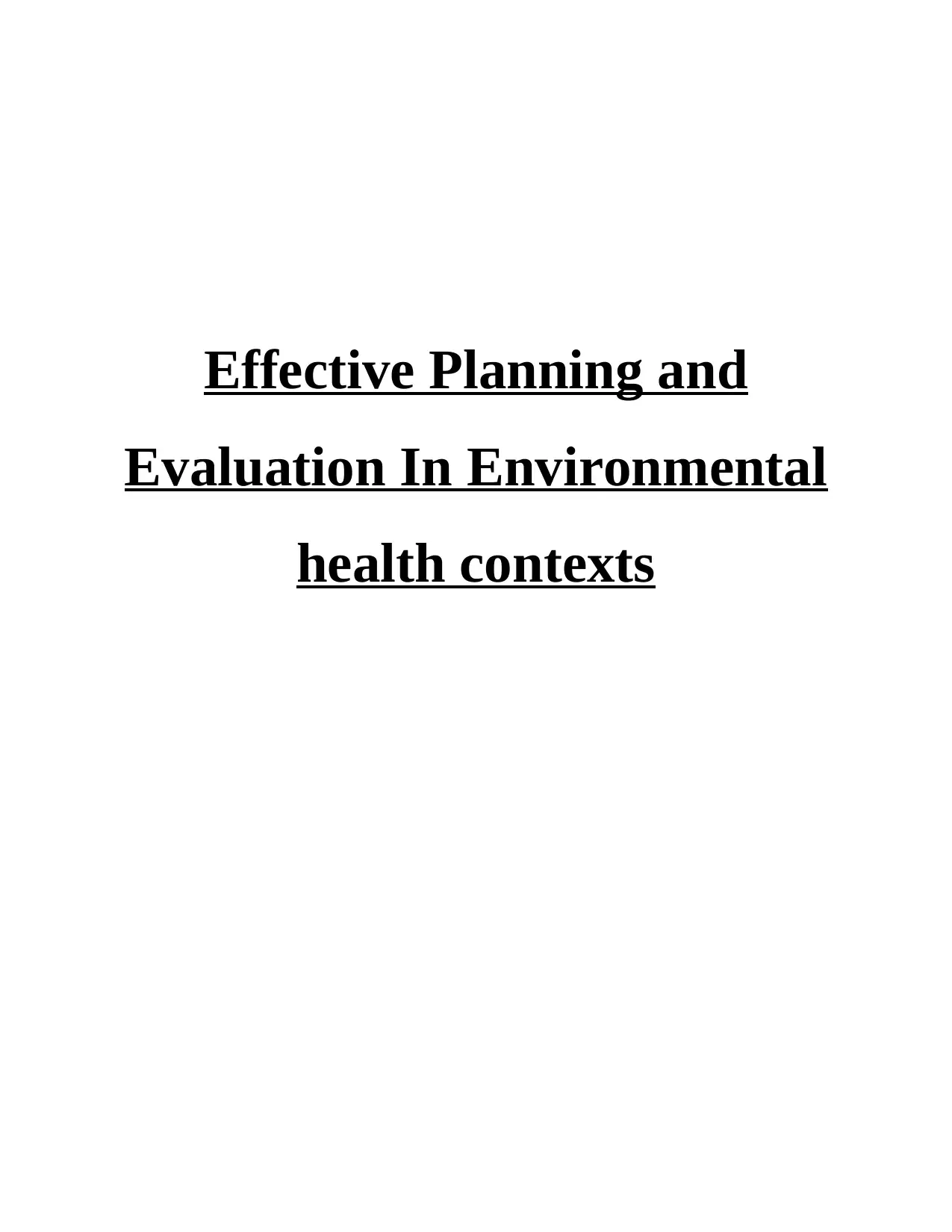
Effective Planning and
Evaluation In Environmental
health contexts
Evaluation In Environmental
health contexts
Paraphrase This Document
Need a fresh take? Get an instant paraphrase of this document with our AI Paraphraser
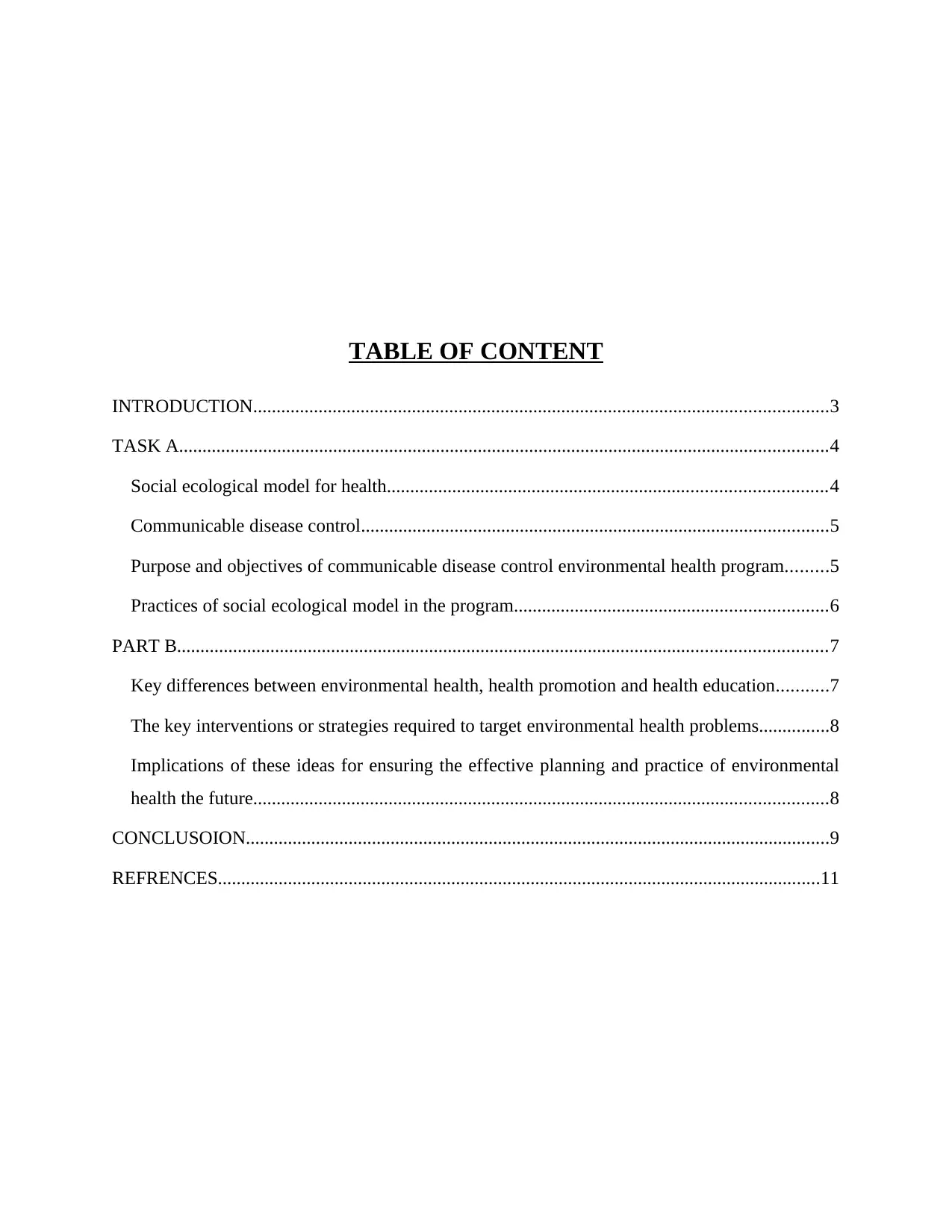
TABLE OF CONTENT
INTRODUCTION...........................................................................................................................3
TASK A...........................................................................................................................................4
Social ecological model for health..............................................................................................4
Communicable disease control....................................................................................................5
Purpose and objectives of communicable disease control environmental health program.........5
Practices of social ecological model in the program...................................................................6
PART B...........................................................................................................................................7
Key differences between environmental health, health promotion and health education...........7
The key interventions or strategies required to target environmental health problems...............8
Implications of these ideas for ensuring the effective planning and practice of environmental
health the future...........................................................................................................................8
CONCLUSOION.............................................................................................................................9
REFRENCES.................................................................................................................................11
INTRODUCTION...........................................................................................................................3
TASK A...........................................................................................................................................4
Social ecological model for health..............................................................................................4
Communicable disease control....................................................................................................5
Purpose and objectives of communicable disease control environmental health program.........5
Practices of social ecological model in the program...................................................................6
PART B...........................................................................................................................................7
Key differences between environmental health, health promotion and health education...........7
The key interventions or strategies required to target environmental health problems...............8
Implications of these ideas for ensuring the effective planning and practice of environmental
health the future...........................................................................................................................8
CONCLUSOION.............................................................................................................................9
REFRENCES.................................................................................................................................11
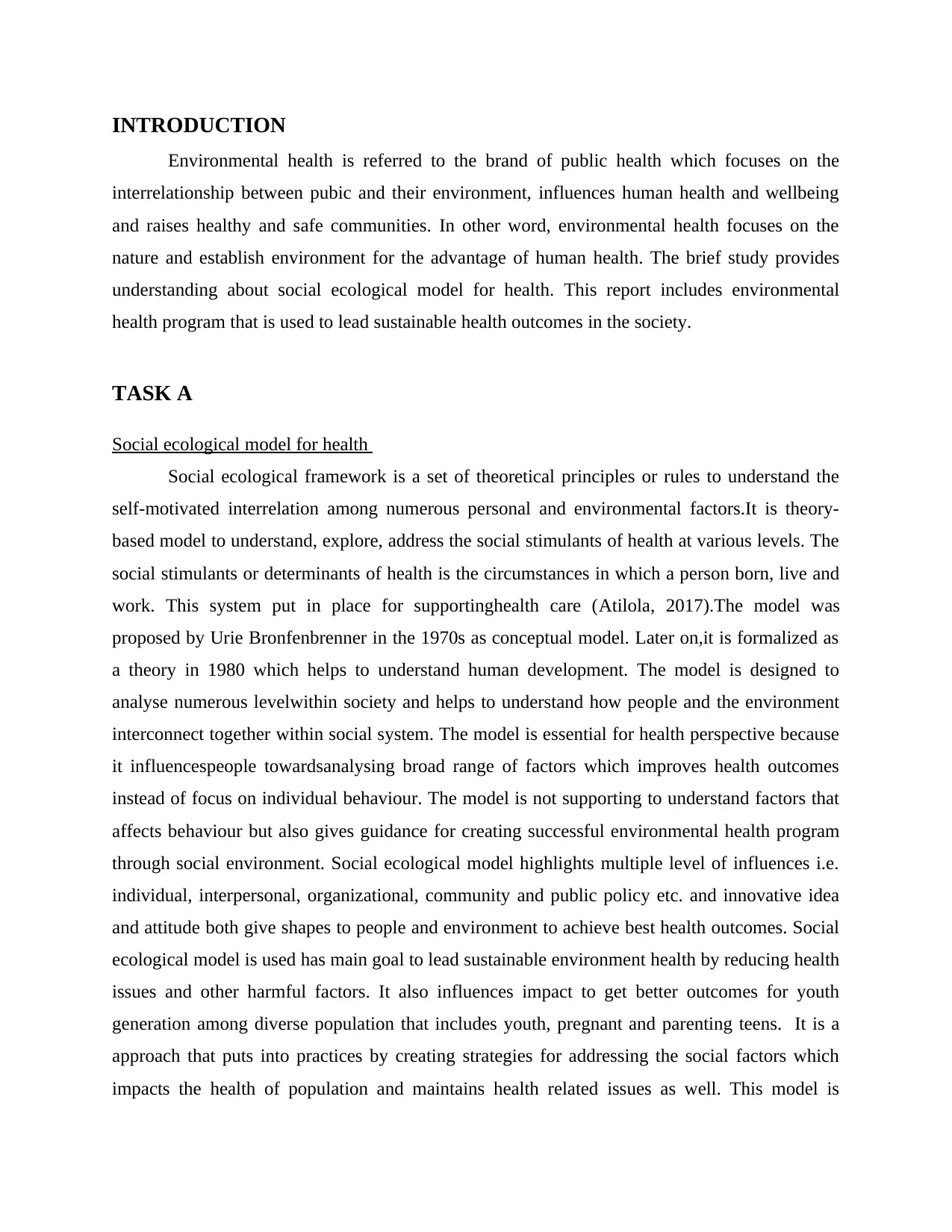
INTRODUCTION
Environmental health is referred to the brand of public health which focuses on the
interrelationship between pubic and their environment, influences human health and wellbeing
and raises healthy and safe communities. In other word, environmental health focuses on the
nature and establish environment for the advantage of human health. The brief study provides
understanding about social ecological model for health. This report includes environmental
health program that is used to lead sustainable health outcomes in the society.
TASK A
Social ecological model for health
Social ecological framework is a set of theoretical principles or rules to understand the
self-motivated interrelation among numerous personal and environmental factors.It is theory-
based model to understand, explore, address the social stimulants of health at various levels. The
social stimulants or determinants of health is the circumstances in which a person born, live and
work. This system put in place for supportinghealth care (Atilola, 2017).The model was
proposed by Urie Bronfenbrenner in the 1970s as conceptual model. Later on,it is formalized as
a theory in 1980 which helps to understand human development. The model is designed to
analyse numerous levelwithin society and helps to understand how people and the environment
interconnect together within social system. The model is essential for health perspective because
it influencespeople towardsanalysing broad range of factors which improves health outcomes
instead of focus on individual behaviour. The model is not supporting to understand factors that
affects behaviour but also gives guidance for creating successful environmental health program
through social environment. Social ecological model highlights multiple level of influences i.e.
individual, interpersonal, organizational, community and public policy etc. and innovative idea
and attitude both give shapes to people and environment to achieve best health outcomes. Social
ecological model is used has main goal to lead sustainable environment health by reducing health
issues and other harmful factors. It also influences impact to get better outcomes for youth
generation among diverse population that includes youth, pregnant and parenting teens. It is a
approach that puts into practices by creating strategies for addressing the social factors which
impacts the health of population and maintains health related issues as well. This model is
Environmental health is referred to the brand of public health which focuses on the
interrelationship between pubic and their environment, influences human health and wellbeing
and raises healthy and safe communities. In other word, environmental health focuses on the
nature and establish environment for the advantage of human health. The brief study provides
understanding about social ecological model for health. This report includes environmental
health program that is used to lead sustainable health outcomes in the society.
TASK A
Social ecological model for health
Social ecological framework is a set of theoretical principles or rules to understand the
self-motivated interrelation among numerous personal and environmental factors.It is theory-
based model to understand, explore, address the social stimulants of health at various levels. The
social stimulants or determinants of health is the circumstances in which a person born, live and
work. This system put in place for supportinghealth care (Atilola, 2017).The model was
proposed by Urie Bronfenbrenner in the 1970s as conceptual model. Later on,it is formalized as
a theory in 1980 which helps to understand human development. The model is designed to
analyse numerous levelwithin society and helps to understand how people and the environment
interconnect together within social system. The model is essential for health perspective because
it influencespeople towardsanalysing broad range of factors which improves health outcomes
instead of focus on individual behaviour. The model is not supporting to understand factors that
affects behaviour but also gives guidance for creating successful environmental health program
through social environment. Social ecological model highlights multiple level of influences i.e.
individual, interpersonal, organizational, community and public policy etc. and innovative idea
and attitude both give shapes to people and environment to achieve best health outcomes. Social
ecological model is used has main goal to lead sustainable environment health by reducing health
issues and other harmful factors. It also influences impact to get better outcomes for youth
generation among diverse population that includes youth, pregnant and parenting teens. It is a
approach that puts into practices by creating strategies for addressing the social factors which
impacts the health of population and maintains health related issues as well. This model is
⊘ This is a preview!⊘
Do you want full access?
Subscribe today to unlock all pages.

Trusted by 1+ million students worldwide
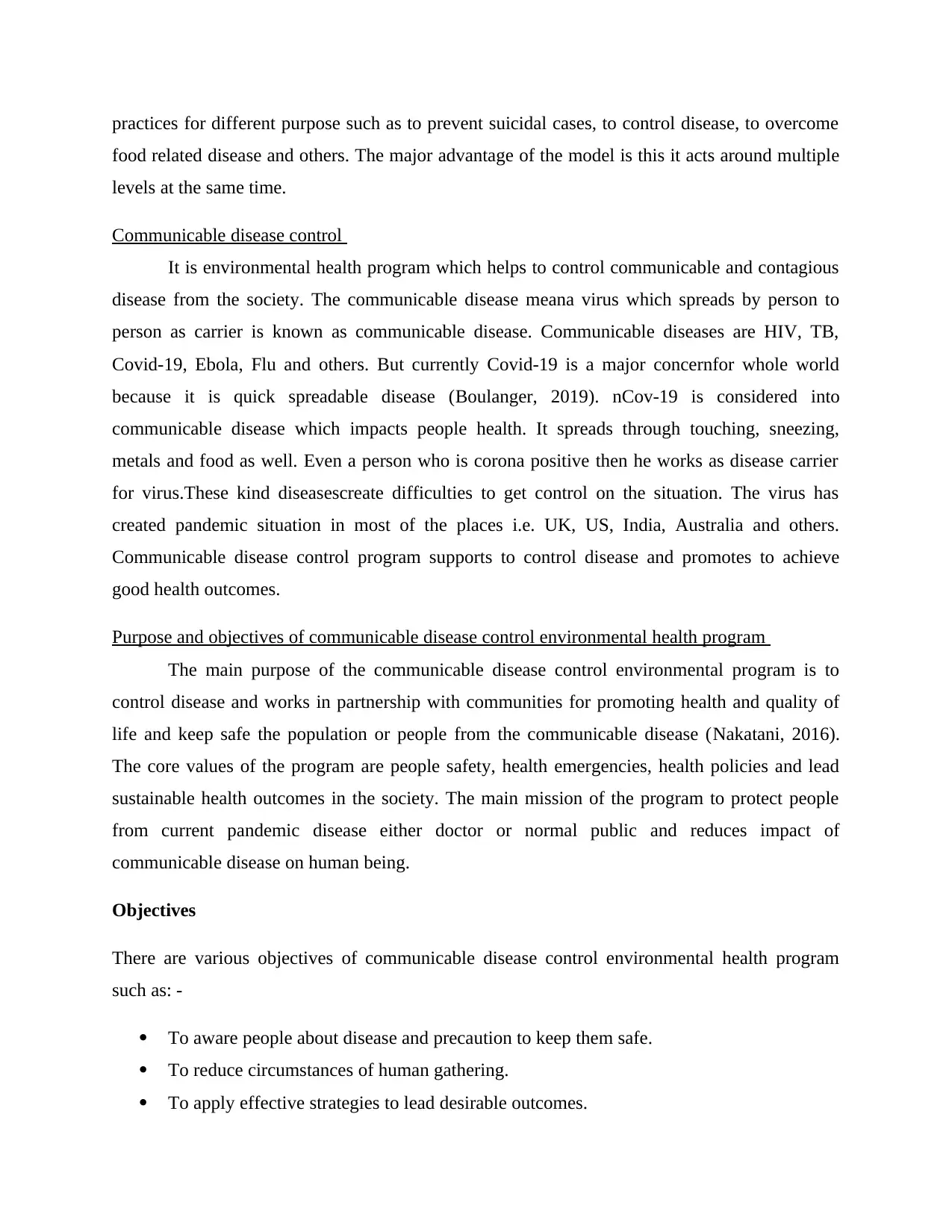
practices for different purpose such as to prevent suicidal cases, to control disease, to overcome
food related disease and others. The major advantage of the model is this it acts around multiple
levels at the same time.
Communicable disease control
It is environmental health program which helps to control communicable and contagious
disease from the society. The communicable disease meana virus which spreads by person to
person as carrier is known as communicable disease. Communicable diseases are HIV, TB,
Covid-19, Ebola, Flu and others. But currently Covid-19 is a major concernfor whole world
because it is quick spreadable disease (Boulanger, 2019). nCov-19 is considered into
communicable disease which impacts people health. It spreads through touching, sneezing,
metals and food as well. Even a person who is corona positive then he works as disease carrier
for virus.These kind diseasescreate difficulties to get control on the situation. The virus has
created pandemic situation in most of the places i.e. UK, US, India, Australia and others.
Communicable disease control program supports to control disease and promotes to achieve
good health outcomes.
Purpose and objectives of communicable disease control environmental health program
The main purpose of the communicable disease control environmental program is to
control disease and works in partnership with communities for promoting health and quality of
life and keep safe the population or people from the communicable disease (Nakatani, 2016).
The core values of the program are people safety, health emergencies, health policies and lead
sustainable health outcomes in the society. The main mission of the program to protect people
from current pandemic disease either doctor or normal public and reduces impact of
communicable disease on human being.
Objectives
There are various objectives of communicable disease control environmental health program
such as: -
To aware people about disease and precaution to keep them safe.
To reduce circumstances of human gathering.
To apply effective strategies to lead desirable outcomes.
food related disease and others. The major advantage of the model is this it acts around multiple
levels at the same time.
Communicable disease control
It is environmental health program which helps to control communicable and contagious
disease from the society. The communicable disease meana virus which spreads by person to
person as carrier is known as communicable disease. Communicable diseases are HIV, TB,
Covid-19, Ebola, Flu and others. But currently Covid-19 is a major concernfor whole world
because it is quick spreadable disease (Boulanger, 2019). nCov-19 is considered into
communicable disease which impacts people health. It spreads through touching, sneezing,
metals and food as well. Even a person who is corona positive then he works as disease carrier
for virus.These kind diseasescreate difficulties to get control on the situation. The virus has
created pandemic situation in most of the places i.e. UK, US, India, Australia and others.
Communicable disease control program supports to control disease and promotes to achieve
good health outcomes.
Purpose and objectives of communicable disease control environmental health program
The main purpose of the communicable disease control environmental program is to
control disease and works in partnership with communities for promoting health and quality of
life and keep safe the population or people from the communicable disease (Nakatani, 2016).
The core values of the program are people safety, health emergencies, health policies and lead
sustainable health outcomes in the society. The main mission of the program to protect people
from current pandemic disease either doctor or normal public and reduces impact of
communicable disease on human being.
Objectives
There are various objectives of communicable disease control environmental health program
such as: -
To aware people about disease and precaution to keep them safe.
To reduce circumstances of human gathering.
To apply effective strategies to lead desirable outcomes.
Paraphrase This Document
Need a fresh take? Get an instant paraphrase of this document with our AI Paraphraser
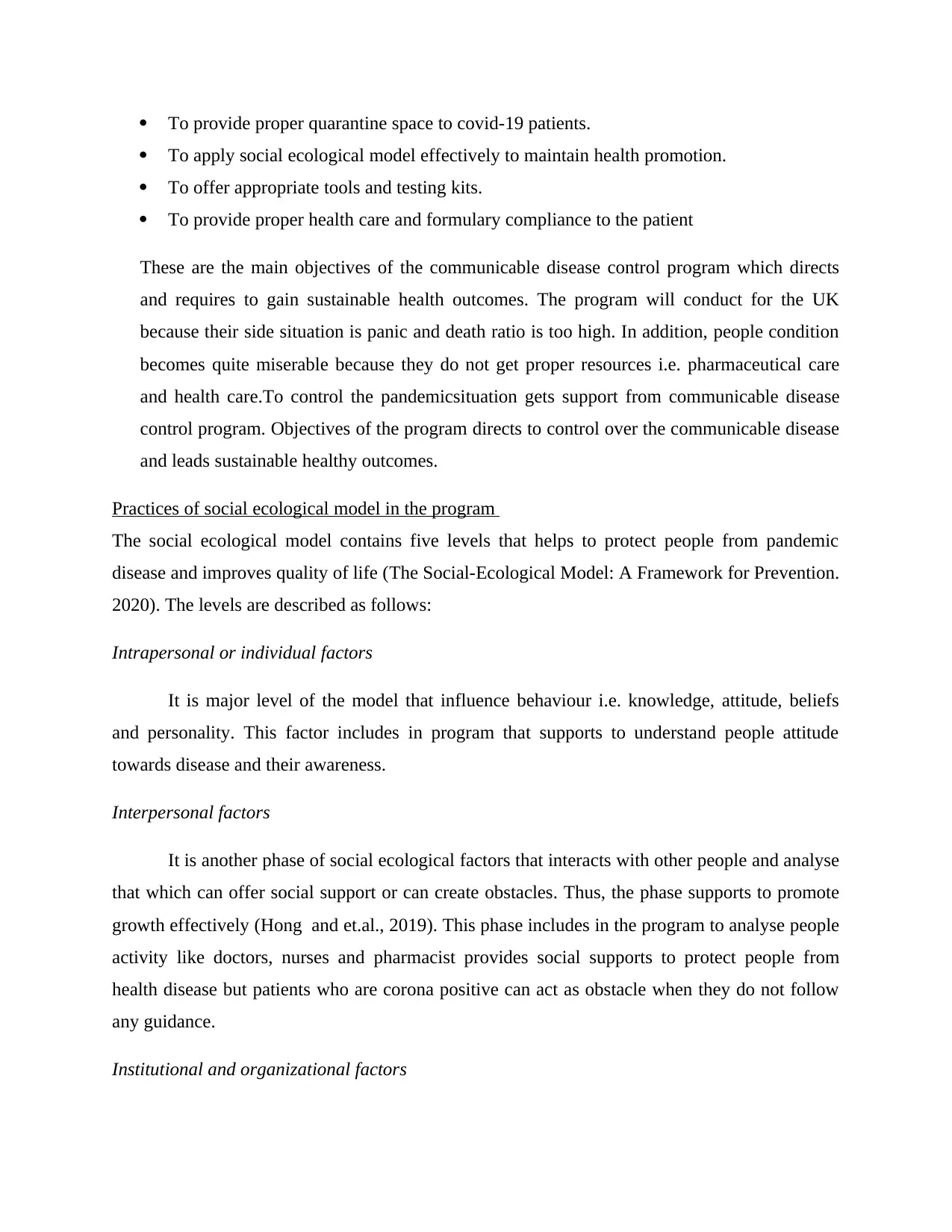
To provide proper quarantine space to covid-19 patients.
To apply social ecological model effectively to maintain health promotion.
To offer appropriate tools and testing kits.
To provide proper health care and formulary compliance to the patient
These are the main objectives of the communicable disease control program which directs
and requires to gain sustainable health outcomes. The program will conduct for the UK
because their side situation is panic and death ratio is too high. In addition, people condition
becomes quite miserable because they do not get proper resources i.e. pharmaceutical care
and health care.To control the pandemicsituation gets support from communicable disease
control program. Objectives of the program directs to control over the communicable disease
and leads sustainable healthy outcomes.
Practices of social ecological model in the program
The social ecological model contains five levels that helps to protect people from pandemic
disease and improves quality of life (The Social-Ecological Model: A Framework for Prevention.
2020). The levels are described as follows:
Intrapersonal or individual factors
It is major level of the model that influence behaviour i.e. knowledge, attitude, beliefs
and personality. This factor includes in program that supports to understand people attitude
towards disease and their awareness.
Interpersonal factors
It is another phase of social ecological factors that interacts with other people and analyse
that which can offer social support or can create obstacles. Thus, the phase supports to promote
growth effectively (Hong and et.al., 2019). This phase includes in the program to analyse people
activity like doctors, nurses and pharmacist provides social supports to protect people from
health disease but patients who are corona positive can act as obstacle when they do not follow
any guidance.
Institutional and organizational factors
To apply social ecological model effectively to maintain health promotion.
To offer appropriate tools and testing kits.
To provide proper health care and formulary compliance to the patient
These are the main objectives of the communicable disease control program which directs
and requires to gain sustainable health outcomes. The program will conduct for the UK
because their side situation is panic and death ratio is too high. In addition, people condition
becomes quite miserable because they do not get proper resources i.e. pharmaceutical care
and health care.To control the pandemicsituation gets support from communicable disease
control program. Objectives of the program directs to control over the communicable disease
and leads sustainable healthy outcomes.
Practices of social ecological model in the program
The social ecological model contains five levels that helps to protect people from pandemic
disease and improves quality of life (The Social-Ecological Model: A Framework for Prevention.
2020). The levels are described as follows:
Intrapersonal or individual factors
It is major level of the model that influence behaviour i.e. knowledge, attitude, beliefs
and personality. This factor includes in program that supports to understand people attitude
towards disease and their awareness.
Interpersonal factors
It is another phase of social ecological factors that interacts with other people and analyse
that which can offer social support or can create obstacles. Thus, the phase supports to promote
growth effectively (Hong and et.al., 2019). This phase includes in the program to analyse people
activity like doctors, nurses and pharmacist provides social supports to protect people from
health disease but patients who are corona positive can act as obstacle when they do not follow
any guidance.
Institutional and organizational factors
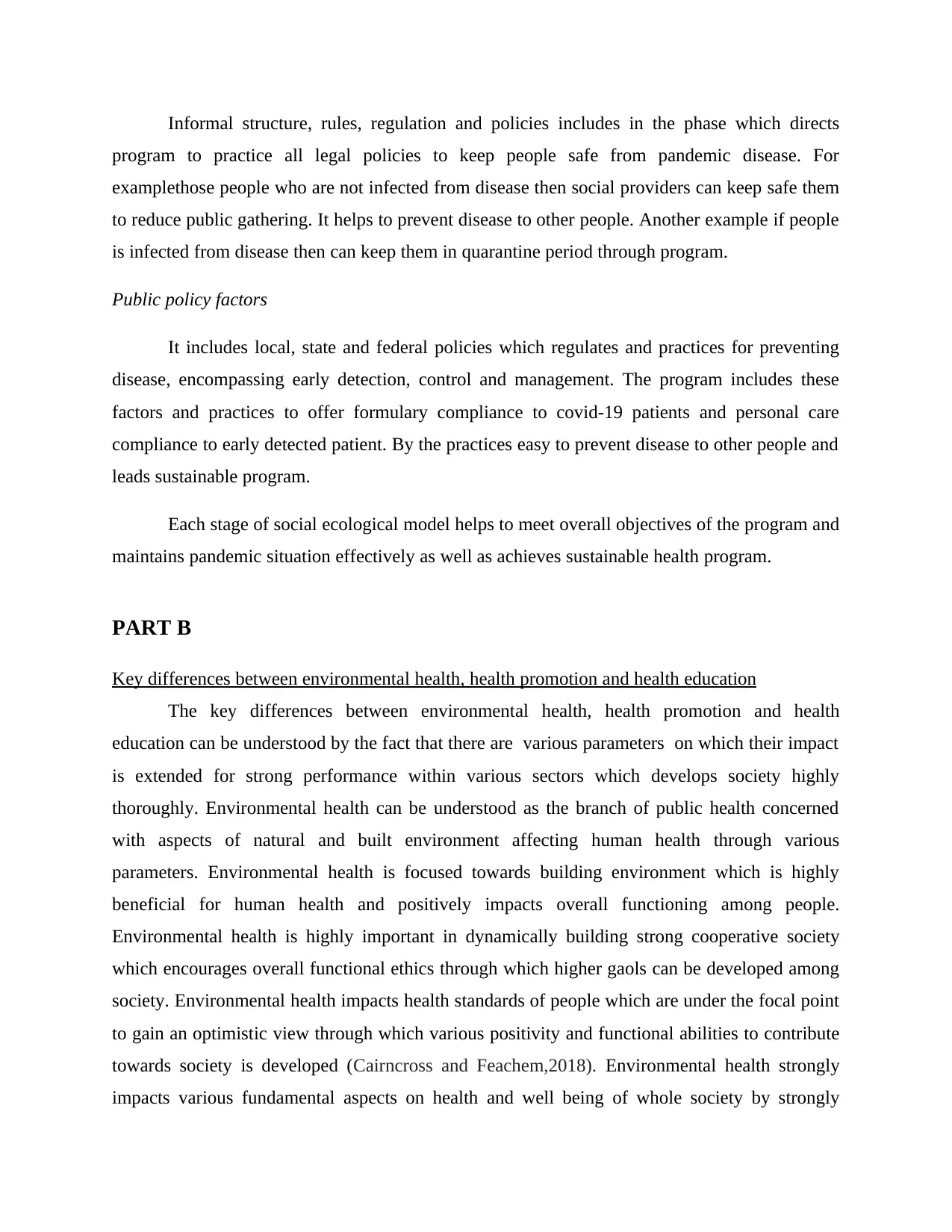
Informal structure, rules, regulation and policies includes in the phase which directs
program to practice all legal policies to keep people safe from pandemic disease. For
examplethose people who are not infected from disease then social providers can keep safe them
to reduce public gathering. It helps to prevent disease to other people. Another example if people
is infected from disease then can keep them in quarantine period through program.
Public policy factors
It includes local, state and federal policies which regulates and practices for preventing
disease, encompassing early detection, control and management. The program includes these
factors and practices to offer formulary compliance to covid-19 patients and personal care
compliance to early detected patient. By the practices easy to prevent disease to other people and
leads sustainable program.
Each stage of social ecological model helps to meet overall objectives of the program and
maintains pandemic situation effectively as well as achieves sustainable health program.
PART B
Key differences between environmental health, health promotion and health education
The key differences between environmental health, health promotion and health
education can be understood by the fact that there are various parameters on which their impact
is extended for strong performance within various sectors which develops society highly
thoroughly. Environmental health can be understood as the branch of public health concerned
with aspects of natural and built environment affecting human health through various
parameters. Environmental health is focused towards building environment which is highly
beneficial for human health and positively impacts overall functioning among people.
Environmental health is highly important in dynamically building strong cooperative society
which encourages overall functional ethics through which higher gaols can be developed among
society. Environmental health impacts health standards of people which are under the focal point
to gain an optimistic view through which various positivity and functional abilities to contribute
towards society is developed (Cairncross and Feachem,2018). Environmental health strongly
impacts various fundamental aspects on health and well being of whole society by strongly
program to practice all legal policies to keep people safe from pandemic disease. For
examplethose people who are not infected from disease then social providers can keep safe them
to reduce public gathering. It helps to prevent disease to other people. Another example if people
is infected from disease then can keep them in quarantine period through program.
Public policy factors
It includes local, state and federal policies which regulates and practices for preventing
disease, encompassing early detection, control and management. The program includes these
factors and practices to offer formulary compliance to covid-19 patients and personal care
compliance to early detected patient. By the practices easy to prevent disease to other people and
leads sustainable program.
Each stage of social ecological model helps to meet overall objectives of the program and
maintains pandemic situation effectively as well as achieves sustainable health program.
PART B
Key differences between environmental health, health promotion and health education
The key differences between environmental health, health promotion and health
education can be understood by the fact that there are various parameters on which their impact
is extended for strong performance within various sectors which develops society highly
thoroughly. Environmental health can be understood as the branch of public health concerned
with aspects of natural and built environment affecting human health through various
parameters. Environmental health is focused towards building environment which is highly
beneficial for human health and positively impacts overall functioning among people.
Environmental health is highly important in dynamically building strong cooperative society
which encourages overall functional ethics through which higher gaols can be developed among
society. Environmental health impacts health standards of people which are under the focal point
to gain an optimistic view through which various positivity and functional abilities to contribute
towards society is developed (Cairncross and Feachem,2018). Environmental health strongly
impacts various fundamental aspects on health and well being of whole society by strongly
⊘ This is a preview!⊘
Do you want full access?
Subscribe today to unlock all pages.

Trusted by 1+ million students worldwide
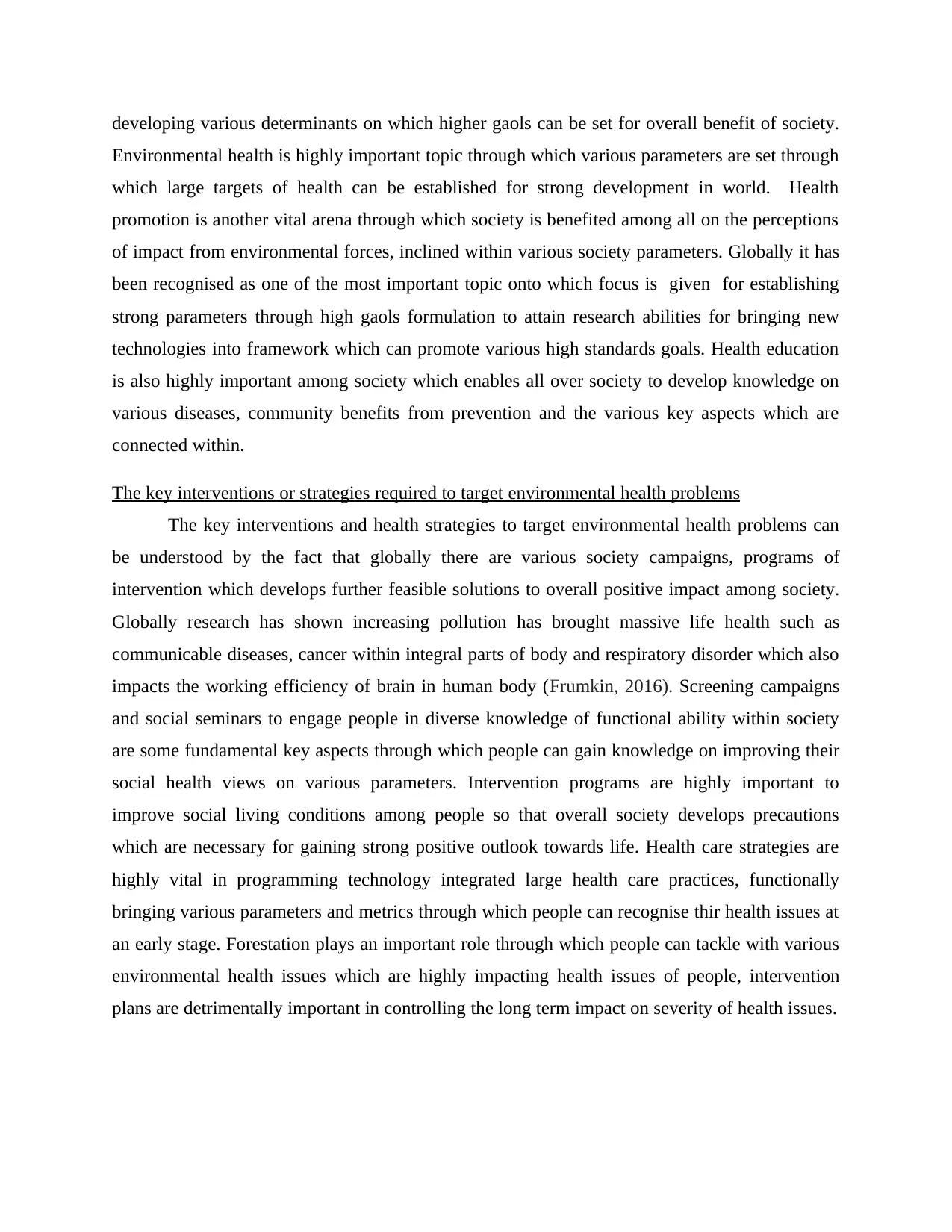
developing various determinants on which higher gaols can be set for overall benefit of society.
Environmental health is highly important topic through which various parameters are set through
which large targets of health can be established for strong development in world. Health
promotion is another vital arena through which society is benefited among all on the perceptions
of impact from environmental forces, inclined within various society parameters. Globally it has
been recognised as one of the most important topic onto which focus is given for establishing
strong parameters through high gaols formulation to attain research abilities for bringing new
technologies into framework which can promote various high standards goals. Health education
is also highly important among society which enables all over society to develop knowledge on
various diseases, community benefits from prevention and the various key aspects which are
connected within.
The key interventions or strategies required to target environmental health problems
The key interventions and health strategies to target environmental health problems can
be understood by the fact that globally there are various society campaigns, programs of
intervention which develops further feasible solutions to overall positive impact among society.
Globally research has shown increasing pollution has brought massive life health such as
communicable diseases, cancer within integral parts of body and respiratory disorder which also
impacts the working efficiency of brain in human body (Frumkin, 2016). Screening campaigns
and social seminars to engage people in diverse knowledge of functional ability within society
are some fundamental key aspects through which people can gain knowledge on improving their
social health views on various parameters. Intervention programs are highly important to
improve social living conditions among people so that overall society develops precautions
which are necessary for gaining strong positive outlook towards life. Health care strategies are
highly vital in programming technology integrated large health care practices, functionally
bringing various parameters and metrics through which people can recognise thir health issues at
an early stage. Forestation plays an important role through which people can tackle with various
environmental health issues which are highly impacting health issues of people, intervention
plans are detrimentally important in controlling the long term impact on severity of health issues.
Environmental health is highly important topic through which various parameters are set through
which large targets of health can be established for strong development in world. Health
promotion is another vital arena through which society is benefited among all on the perceptions
of impact from environmental forces, inclined within various society parameters. Globally it has
been recognised as one of the most important topic onto which focus is given for establishing
strong parameters through high gaols formulation to attain research abilities for bringing new
technologies into framework which can promote various high standards goals. Health education
is also highly important among society which enables all over society to develop knowledge on
various diseases, community benefits from prevention and the various key aspects which are
connected within.
The key interventions or strategies required to target environmental health problems
The key interventions and health strategies to target environmental health problems can
be understood by the fact that globally there are various society campaigns, programs of
intervention which develops further feasible solutions to overall positive impact among society.
Globally research has shown increasing pollution has brought massive life health such as
communicable diseases, cancer within integral parts of body and respiratory disorder which also
impacts the working efficiency of brain in human body (Frumkin, 2016). Screening campaigns
and social seminars to engage people in diverse knowledge of functional ability within society
are some fundamental key aspects through which people can gain knowledge on improving their
social health views on various parameters. Intervention programs are highly important to
improve social living conditions among people so that overall society develops precautions
which are necessary for gaining strong positive outlook towards life. Health care strategies are
highly vital in programming technology integrated large health care practices, functionally
bringing various parameters and metrics through which people can recognise thir health issues at
an early stage. Forestation plays an important role through which people can tackle with various
environmental health issues which are highly impacting health issues of people, intervention
plans are detrimentally important in controlling the long term impact on severity of health issues.
Paraphrase This Document
Need a fresh take? Get an instant paraphrase of this document with our AI Paraphraser
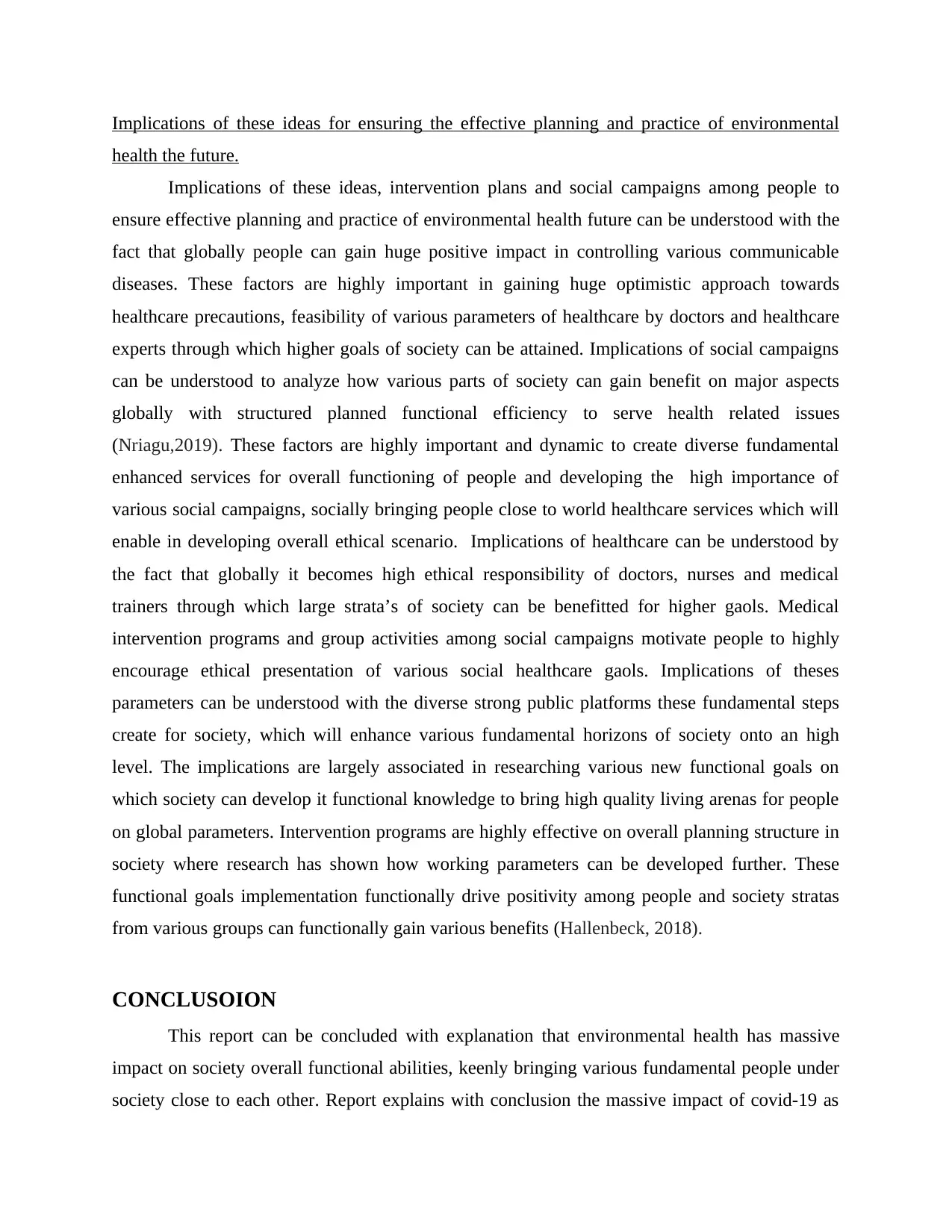
Implications of these ideas for ensuring the effective planning and practice of environmental
health the future.
Implications of these ideas, intervention plans and social campaigns among people to
ensure effective planning and practice of environmental health future can be understood with the
fact that globally people can gain huge positive impact in controlling various communicable
diseases. These factors are highly important in gaining huge optimistic approach towards
healthcare precautions, feasibility of various parameters of healthcare by doctors and healthcare
experts through which higher goals of society can be attained. Implications of social campaigns
can be understood to analyze how various parts of society can gain benefit on major aspects
globally with structured planned functional efficiency to serve health related issues
(Nriagu,2019). These factors are highly important and dynamic to create diverse fundamental
enhanced services for overall functioning of people and developing the high importance of
various social campaigns, socially bringing people close to world healthcare services which will
enable in developing overall ethical scenario. Implications of healthcare can be understood by
the fact that globally it becomes high ethical responsibility of doctors, nurses and medical
trainers through which large strata’s of society can be benefitted for higher gaols. Medical
intervention programs and group activities among social campaigns motivate people to highly
encourage ethical presentation of various social healthcare gaols. Implications of theses
parameters can be understood with the diverse strong public platforms these fundamental steps
create for society, which will enhance various fundamental horizons of society onto an high
level. The implications are largely associated in researching various new functional goals on
which society can develop it functional knowledge to bring high quality living arenas for people
on global parameters. Intervention programs are highly effective on overall planning structure in
society where research has shown how working parameters can be developed further. These
functional goals implementation functionally drive positivity among people and society stratas
from various groups can functionally gain various benefits (Hallenbeck, 2018).
CONCLUSOION
This report can be concluded with explanation that environmental health has massive
impact on society overall functional abilities, keenly bringing various fundamental people under
society close to each other. Report explains with conclusion the massive impact of covid-19 as
health the future.
Implications of these ideas, intervention plans and social campaigns among people to
ensure effective planning and practice of environmental health future can be understood with the
fact that globally people can gain huge positive impact in controlling various communicable
diseases. These factors are highly important in gaining huge optimistic approach towards
healthcare precautions, feasibility of various parameters of healthcare by doctors and healthcare
experts through which higher goals of society can be attained. Implications of social campaigns
can be understood to analyze how various parts of society can gain benefit on major aspects
globally with structured planned functional efficiency to serve health related issues
(Nriagu,2019). These factors are highly important and dynamic to create diverse fundamental
enhanced services for overall functioning of people and developing the high importance of
various social campaigns, socially bringing people close to world healthcare services which will
enable in developing overall ethical scenario. Implications of healthcare can be understood by
the fact that globally it becomes high ethical responsibility of doctors, nurses and medical
trainers through which large strata’s of society can be benefitted for higher gaols. Medical
intervention programs and group activities among social campaigns motivate people to highly
encourage ethical presentation of various social healthcare gaols. Implications of theses
parameters can be understood with the diverse strong public platforms these fundamental steps
create for society, which will enhance various fundamental horizons of society onto an high
level. The implications are largely associated in researching various new functional goals on
which society can develop it functional knowledge to bring high quality living arenas for people
on global parameters. Intervention programs are highly effective on overall planning structure in
society where research has shown how working parameters can be developed further. These
functional goals implementation functionally drive positivity among people and society stratas
from various groups can functionally gain various benefits (Hallenbeck, 2018).
CONCLUSOION
This report can be concluded with explanation that environmental health has massive
impact on society overall functional abilities, keenly bringing various fundamental people under
society close to each other. Report explains with conclusion the massive impact of covid-19 as
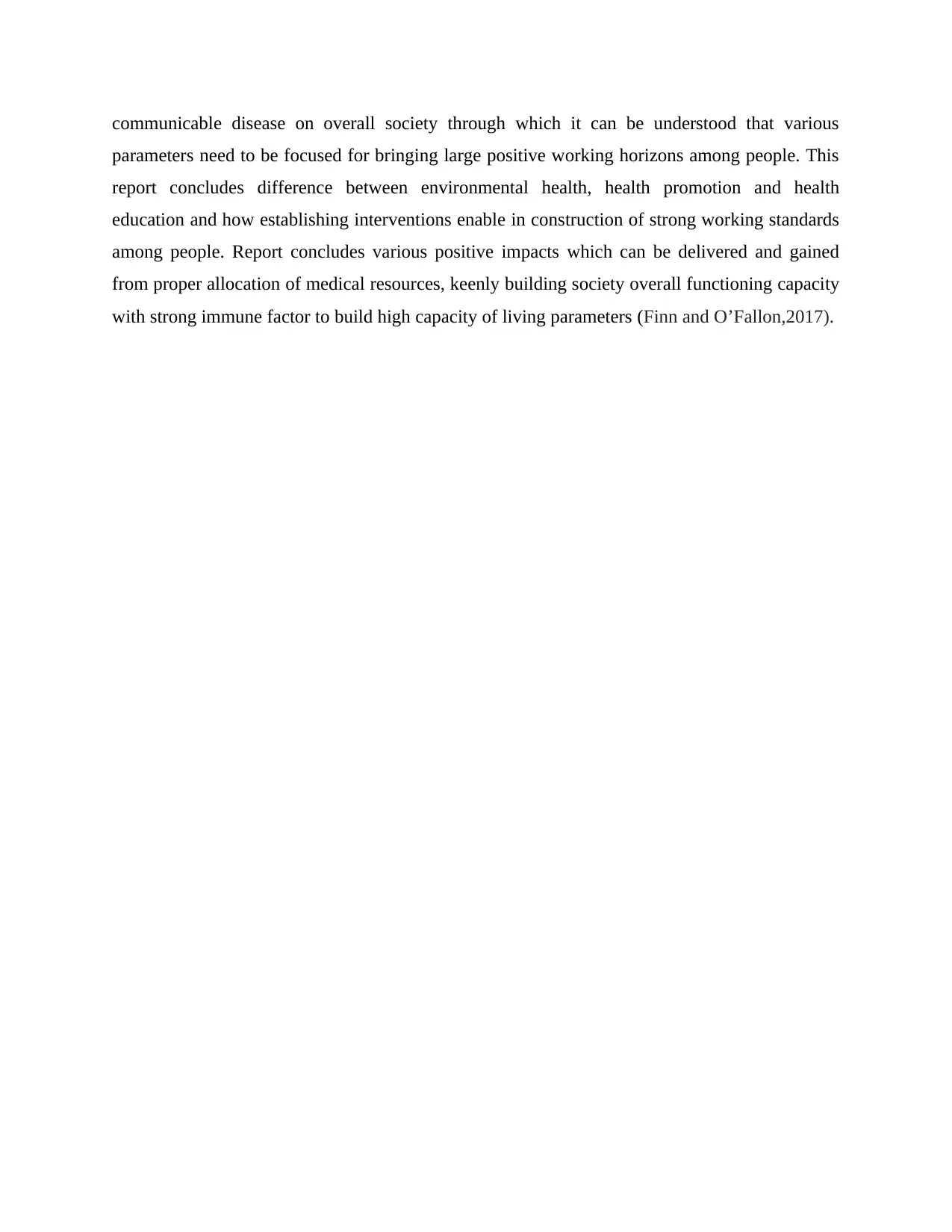
communicable disease on overall society through which it can be understood that various
parameters need to be focused for bringing large positive working horizons among people. This
report concludes difference between environmental health, health promotion and health
education and how establishing interventions enable in construction of strong working standards
among people. Report concludes various positive impacts which can be delivered and gained
from proper allocation of medical resources, keenly building society overall functioning capacity
with strong immune factor to build high capacity of living parameters (Finn and O’Fallon,2017).
parameters need to be focused for bringing large positive working horizons among people. This
report concludes difference between environmental health, health promotion and health
education and how establishing interventions enable in construction of strong working standards
among people. Report concludes various positive impacts which can be delivered and gained
from proper allocation of medical resources, keenly building society overall functioning capacity
with strong immune factor to build high capacity of living parameters (Finn and O’Fallon,2017).
⊘ This is a preview!⊘
Do you want full access?
Subscribe today to unlock all pages.

Trusted by 1+ million students worldwide
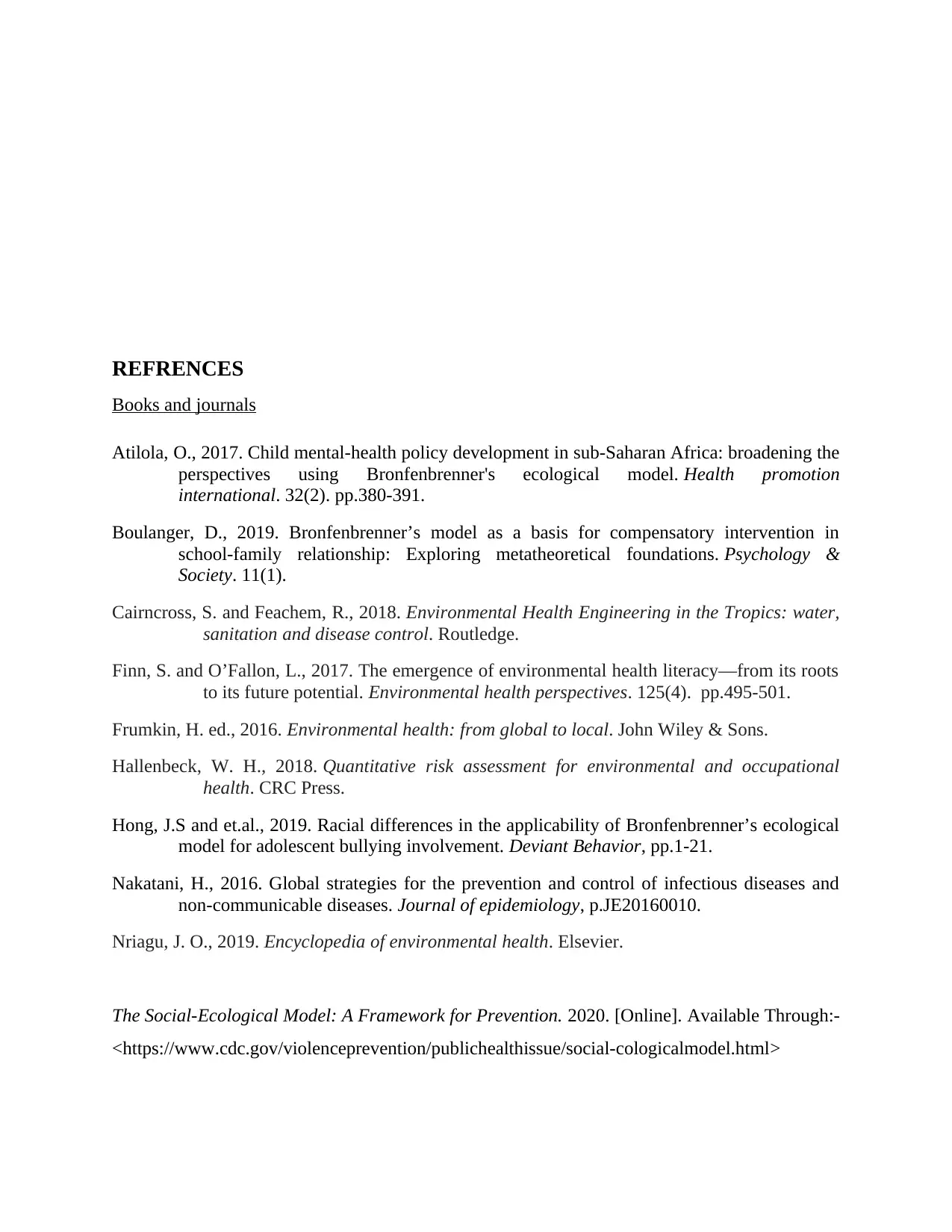
REFRENCES
Books and journals
Atilola, O., 2017. Child mental-health policy development in sub-Saharan Africa: broadening the
perspectives using Bronfenbrenner's ecological model. Health promotion
international. 32(2). pp.380-391.
Boulanger, D., 2019. Bronfenbrenner’s model as a basis for compensatory intervention in
school-family relationship: Exploring metatheoretical foundations. Psychology &
Society. 11(1).
Cairncross, S. and Feachem, R., 2018. Environmental Health Engineering in the Tropics: water,
sanitation and disease control. Routledge.
Finn, S. and O’Fallon, L., 2017. The emergence of environmental health literacy—from its roots
to its future potential. Environmental health perspectives. 125(4). pp.495-501.
Frumkin, H. ed., 2016. Environmental health: from global to local. John Wiley & Sons.
Hallenbeck, W. H., 2018. Quantitative risk assessment for environmental and occupational
health. CRC Press.
Hong, J.S and et.al., 2019. Racial differences in the applicability of Bronfenbrenner’s ecological
model for adolescent bullying involvement. Deviant Behavior, pp.1-21.
Nakatani, H., 2016. Global strategies for the prevention and control of infectious diseases and
non-communicable diseases. Journal of epidemiology, p.JE20160010.
Nriagu, J. O., 2019. Encyclopedia of environmental health. Elsevier.
The Social-Ecological Model: A Framework for Prevention. 2020. [Online]. Available Through:-
<https://www.cdc.gov/violenceprevention/publichealthissue/social-cologicalmodel.html>
Books and journals
Atilola, O., 2017. Child mental-health policy development in sub-Saharan Africa: broadening the
perspectives using Bronfenbrenner's ecological model. Health promotion
international. 32(2). pp.380-391.
Boulanger, D., 2019. Bronfenbrenner’s model as a basis for compensatory intervention in
school-family relationship: Exploring metatheoretical foundations. Psychology &
Society. 11(1).
Cairncross, S. and Feachem, R., 2018. Environmental Health Engineering in the Tropics: water,
sanitation and disease control. Routledge.
Finn, S. and O’Fallon, L., 2017. The emergence of environmental health literacy—from its roots
to its future potential. Environmental health perspectives. 125(4). pp.495-501.
Frumkin, H. ed., 2016. Environmental health: from global to local. John Wiley & Sons.
Hallenbeck, W. H., 2018. Quantitative risk assessment for environmental and occupational
health. CRC Press.
Hong, J.S and et.al., 2019. Racial differences in the applicability of Bronfenbrenner’s ecological
model for adolescent bullying involvement. Deviant Behavior, pp.1-21.
Nakatani, H., 2016. Global strategies for the prevention and control of infectious diseases and
non-communicable diseases. Journal of epidemiology, p.JE20160010.
Nriagu, J. O., 2019. Encyclopedia of environmental health. Elsevier.
The Social-Ecological Model: A Framework for Prevention. 2020. [Online]. Available Through:-
<https://www.cdc.gov/violenceprevention/publichealthissue/social-cologicalmodel.html>
Paraphrase This Document
Need a fresh take? Get an instant paraphrase of this document with our AI Paraphraser

1 out of 11
Related Documents
Your All-in-One AI-Powered Toolkit for Academic Success.
+13062052269
info@desklib.com
Available 24*7 on WhatsApp / Email
![[object Object]](/_next/static/media/star-bottom.7253800d.svg)
Unlock your academic potential
Copyright © 2020–2025 A2Z Services. All Rights Reserved. Developed and managed by ZUCOL.





